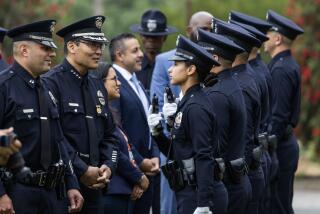Downey Council OKs Only 5 of 6 Officers It Promised
DOWNEY — Police Chief Pete Stone came to the City Council last week armed with a 10-page wish list that detailed a substantial increase in the city’s law enforcement needs for the next five years.
Then the council approved one less police officer than it had previously promised him for the current fiscal year.
Citing concerns about the city’s financial condition, the council on Wednesday unexpectedly backed down on a 4-month-old decision to hire six police officers. By a unanimous vote taken during a special session, the council reduced the number of slots to four police officers and one sergeant. None of the positions authorized by the council on June 28 have been filled.
In addition to that increase, Stone had prepared the five-year projection in an effort to persuade the council to increase the force by 22 new officers, supervisors and support personnel by 1993. The city has 105 uniformed police officers.
“A realistic examination of the future indicates that an increase (in the need for added police protection), rather than a decrease, is quite likely,” Stone wrote in the Sept. 30 document to City Manager Don Davis. The document was then forwarded to City Council members to study before Stone made his presentation last week.
‘May Appear to Be Excessive’
Stone requested authorization to hire 10 officers and one supervisor over the next five years. He also asked for six new investigators, two new administrators and three new police clerks.
“While the increase of 10 police officers may appear to be excessive, we must take into account the fact that we are a 24-hour, 365-day-a-year operation,” Stone wrote. “Determination of adequate staffing levels for police operations is a complex and often controversial subject.”
Instead of considering the new positions sought by Stone, the council decided to drop the sixth slot, at least until after next year’s budget session.
“There were budget considerations by the council to be made,” Davis said. “The council thought it best to phase into any increases more slowly. We are going to try to live within our revenue growth, rather than try to live with raised taxes and assessment,” Davis said, adding that the five positions will cost the city about $270,000.
The new positions will be paid for from the city’s $4-million reserve fund or through cutbacks in other areas, Davis said, adding that he expects the positions to be filled early next year.
Mayor Robert G. Cormack called the council decision a compromise. He said he had supported hiring more uniformed police but joined in the unanimous vote on the assurance that the department’s hiring needs will be reviewed next year. “We will see what the budget session brings,” he said.
Despite the reduction of the one promised police officer, Capt. Dennis Chelstrom said police officials were satisfied with the council action. Stone was unavailable for comment.
“We were promised that the situation would be reviewed in a few months,” Chelstrom said in a telephone interview. “We could get the men we need if the future goes the way (Stone) has predicted.”
Increase in Minorities
Stone had argued that the additional manpower would be necessary to deal with what he described as a growing minority population.
“One area . . . which we believe will have an impact, is an increased minority population with its cultural differences and language barriers,” Stone wrote. Police officials contacted last week said they do not have details of the projected increase.
However, the Downey Unified School District has compiled statistics that show the increase of minorities in the city “has been quite rapid” in the last five years, Assistant School Supt. Ed Potter said.
According to district population estimates, which are based on enrollment figures, 46% of Downey’s residents are members of minority groups, with Latinos making up about 36% and Asians about 9% of the city’s total population, Potter said. The minority population should increase to about 50% by 1990, he said. Downey’s minority population traditionally has fluctuated between 25% and 30%, he added.
In the memorandum, Stone argued that “minority increases also result in subcultures with ethnic newspapers, shops, churches, dining establishments, cluster living, etc., which make assimilation into the life style as we know it a more difficult and lengthier process.”
Cormack agreed. “We need more people on the street. We see an increase (in Asians and Latinos) in Artesia and the Orange County area. It’s obvious that a certain amount of that sort of thing will happen in Downey as well.”
Stone also wrote that the time it takes for police officers to respond to a call for assistance rose from 4.9 minutes in 1981 to 7.6 minutes last year. In 1987, police answered about 29,000 calls, averaging 35 minutes per call, according to Stone’s document. “The average time spent on an incident increased by 261%,” he wrote.
Among other things, Stone’s memo showed that Downey, with a population of 87,000, has one of the lowest officer-to-resident ratios for Southland cities of comparable size. There are 1.27 Downey police officers for every 1,000 residents. El Monte, with a population of 90,000 employs 1.58 officers for every 1,000 residents, and Compton, with a population of 93,000, has 1.48 officers serving 1,000 residents.
More to Read
Sign up for Essential California
The most important California stories and recommendations in your inbox every morning.
You may occasionally receive promotional content from the Los Angeles Times.









